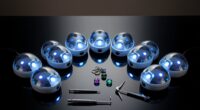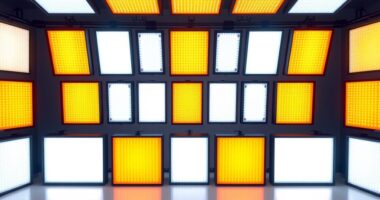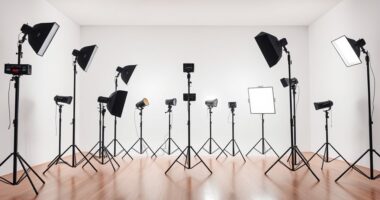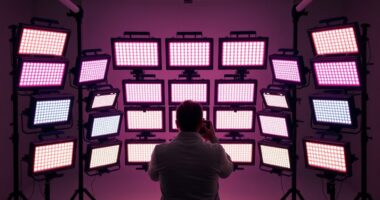Based on the latest options, the two best autoguiders for astrophotography in 2025 are the ZWO ASI174MM Mini and the Orion Nightscout. Both offer excellent tracking accuracy, seamless software integration, and easy setup, making them ideal for sharp shots and long exposures. They’re compatible with a variety of mounts and power sources, ensuring reliable operation. Keep exploring to discover how these tools could transform your astrophotography journey.
Key Takeaways
- Look for autoguiders with sub-arcsecond tracking accuracy for sharp, high-quality astrophotography images.
- Prioritize models compatible with popular control protocols like ASCOM and INDI for seamless software integration.
- Choose lightweight, easy-to-setup autoguiders with reliable power options for efficient field operation.
- Consider budget-friendly options that still offer precise guiding, balancing cost and performance for long exposures.
- Select autoguiders with robust software features like automatic calibration and detailed data logging to ensure perfect tracking.
Star-gazing Guide to Photoshop Astrophotography Image Processing.

If you’re new to astrophotography and want an easy-to-follow guide, the “Star-gazing Guide to Photoshop Astrophotography Image Processing” is perfect for you. I found it incredibly helpful because it uses simple language and clear illustrations to teach basic editing techniques. The book focuses on practical steps with real examples from objects like Orion and the Rosette Nebula. It also provides downloadable raw images, so you can practice along. Many beginners praise its straightforward approach, making complex concepts accessible. If you’re starting out or want a solid foundation, this guide is a fantastic resource to improve your astrophotography editing skills.
Best For: beginners in astrophotography seeking an easy, clear, and practical guide to photo editing using Photoshop.
Pros:
- Uses simple language and visual illustrations, making complex concepts easy to understand.
- Provides downloadable raw images for hands-on practice and skill development.
- Focuses on practical, real-world examples with step-by-step instructions suitable for novices.
Cons:
- Some users experienced difficulties downloading additional software or resources.
- The guide emphasizes basic techniques, potentially lacking in advanced processing methods.
- Limited coverage of other editing programs beyond Photoshop, which may require adaptation for different software.
Colliers Guide to Night Photography in the Great Outdoors – 2nd Edition
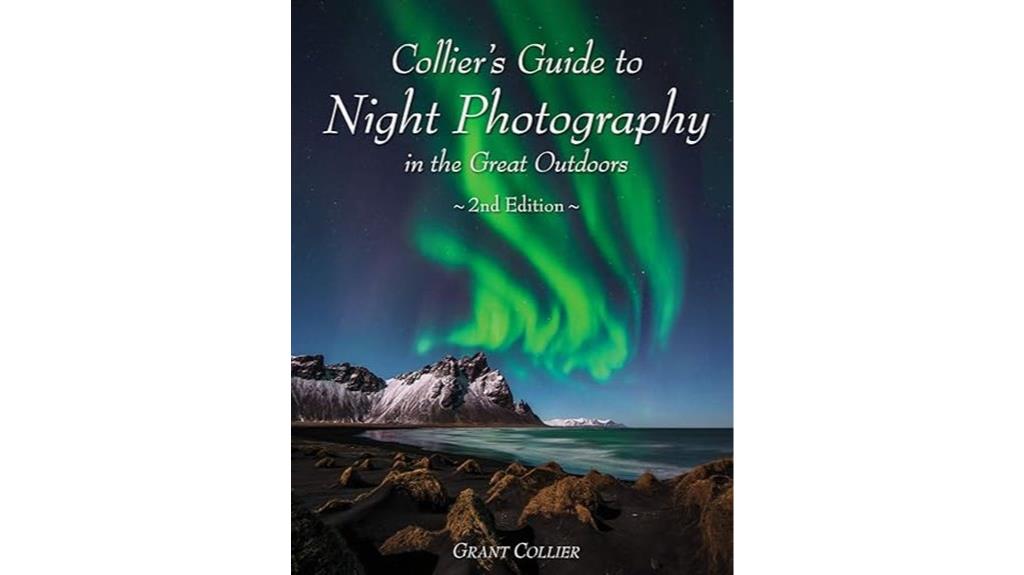
Colliers Guide to Night Photography in the Great Outdoors – 2nd Edition stands out as an essential resource for beginners and semi-professional photographers aiming to master night photography techniques. I’ve found it to be incredibly well-written, engaging, and packed with practical advice. It covers everything from shooting techniques and composition to post-processing, with detailed instructions and EXIF data for most images. Although some gear recommendations are based on older equipment, the core principles remain relevant. If you’re serious about capturing stunning night scenes, this book offers thorough guidance and inspiration that can help you improve your skills markedly.
Best For: beginners and semi-professional photographers seeking a comprehensive, practical guide to night outdoor photography techniques and inspiration.
Pros:
- Well-written, engaging, and easy to follow, suitable for a range of skill levels.
- Provides detailed instructions, EXIF data, and practical advice on shooting and post-processing.
- Features spectacular color images that serve as inspiration and illustrate key concepts.
Cons:
- Some equipment recommendations are based on older gear, which may be less relevant due to rapid technological advancements.
- Might lack illustrative figures or diagrams to further clarify techniques for some readers.
- As technology evolves, parts of the guidance may become outdated, requiring supplementary or updated resources.
Factors to Consider When Choosing Autoguiders for Astrophotography
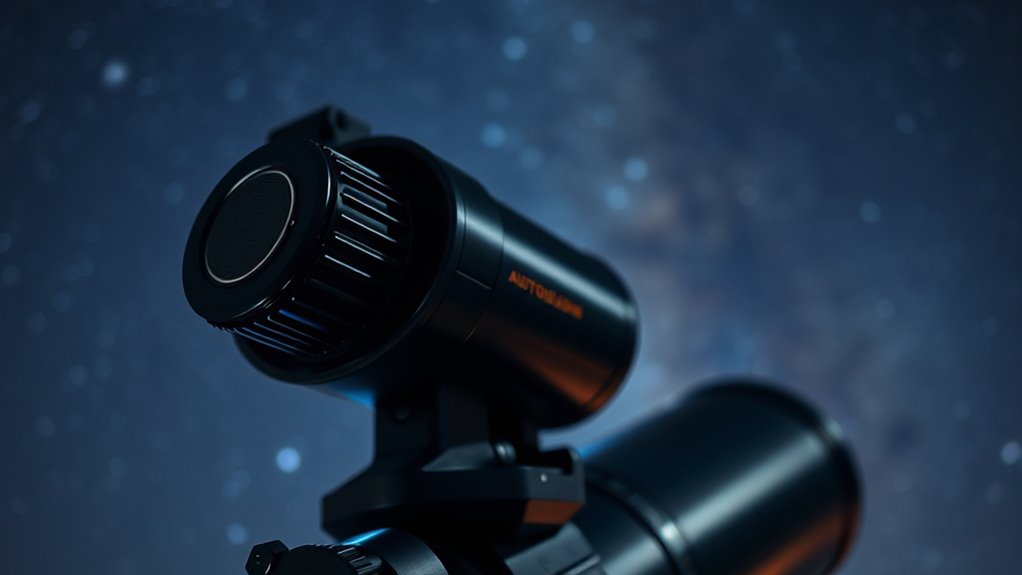
When selecting an autoguider, I consider how well it’s compatible with my mount and whether it offers the tracking accuracy I need. I also look at the available port options and how easy it is to set up, since these can save time and frustration. finally, I check if the power supply matches my system and if the autoguider integrates smoothly with my existing gear.
Compatibility With Mounts
Choosing an autoguider that seamlessly works with your mount requires careful attention to compatibility factors. First, confirm the autoguider supports your mount’s control protocol, like ASCOM or INDI, for smooth operation. Check that its connection interfaces—USB, ST4, or serial—match your mount’s ports. It’s also essential to verify that the autoguider can handle your mount’s payload capacity and tracking accuracy needs. Compatibility with your mount’s calibration procedures ensures precise guiding adjustments. Additionally, confirm whether the autoguider can communicate with your mount’s firmware or software, allowing integrated control. These considerations help avoid connection issues and ensure your guiding system functions reliably, leading to sharper images and more successful astrophotography sessions.
Tracking Precision Level
Achieving high tracking precision is essential for capturing sharp, detailed astrophotography images, especially during long exposures. Sub-arcsecond accuracy ensures star images stay pinpoint sharp, reducing trailing and blurring. This level of accuracy is crucial for deep-sky astrophotography, where exposures can last several minutes or more. The guiding camera’s resolution and the guiding mount’s stability largely determine tracking accuracy. Even slight improvements in precision can considerably decrease post-processing time and elevate image quality. When selecting an autoguider, look for models that offer the highest possible accuracy within your budget. Remember, better tracking precision allows for capturing finer details in faint objects like nebulae and galaxies, making your efforts in choosing the right autoguider well worth it.
Port Connectivity Options
Have you considered how the port connectivity options of an autoguider can influence your astrophotography setup? Most autoguiders connect via USB, which is versatile and widely compatible with computers. Some models also feature dedicated ST-4 ports, allowing direct connection to mount control systems for straightforward guiding. Ethernet ports open up network-based guiding, enabling remote operation over local networks or the internet—ideal for remote observatories. The choice of port impacts setup flexibility, ease of data transfer, and compatibility with your existing equipment. Ensuring your autoguider has the right ports for your mount and computer setup is essential for smooth operation. Selecting the appropriate connectivity options can save you time and frustration, making your astrophotography sessions more seamless and productive.
Ease of Setup
A straightforward and intuitive setup process can make a big difference in how quickly I can start capturing stunning astrophotos. Autoguiders with simple alignment procedures save time and frustration, especially during late-night sessions. Wireless autoguiders remove the hassle of tangled cables, making the setup cleaner and faster. Compatibility with my existing telescope mount and camera means I won’t need extra adapters or modifications, streamlining the entire process. A lightweight and compact autoguider is easier to carry into the field and set up efficiently. Clear, user-friendly software interfaces also help me calibrate quickly and troubleshoot with minimal fuss. Overall, an autoguider that’s easy to set up lets me spend more time imaging and less time fiddling, maximizing my astrophotography sessions.
Power Supply Compatibility
Choosing the right power supply for my autoguider is essential because it guarantees consistent performance during long imaging sessions. I make certain the autoguider’s power input matches my available sources, whether it’s 12V DC, USB, or battery packs. Supporting my preferred power method means I don’t need extra adapters or converters, which simplifies setup. I also check the voltage and current requirements carefully to avoid damaging the device or experiencing performance issues during extended exposures. For remote or lengthy sessions, I consider the autonomy and run-time of the power supply, verifying it can last through the entire session. Finally, I verify compatibility with my mount’s power specifications to ensure smooth, uninterrupted guiding without electrical conflicts.
Software Integration Features
Seamless software integration is essential when selecting an autoguider, as it guarantees smooth communication with your astrophotography tools and enables real-time corrections. Compatibility with popular software platforms and operating systems ensures a flexible workflow and simplifies setup. Advanced autoguiders often feature automatic calibration, detailed data logging, and customizable guiding algorithms, which help optimize tracking accuracy. Additionally, software integration capabilities such as remote control, live view, and feedback loops allow for better monitoring and adjustments during long exposures. The ability to easily update firmware and software components is also critical, as it maintains compatibility with evolving tools and techniques. Overall, strong software integration enhances efficiency, precision, and ease of use, making it a key factor in choosing the right autoguider for astrophotography.
Budget and Cost
Budget and cost are essential factors when selecting an autoguider for astrophotography, as they directly impact your overall setup. Autoguiders range from under $200 for basic models to over $1,000 for high-end options, affecting your total investment. Simpler autoguiders with fewer features and basic sensors are usually more affordable and ideal for beginners or casual astrophotographers. While investing in a pricier model can offer higher accuracy, better build quality, and improved software support, it also increases initial costs. It’s important to contemplate the total expense, including other gear like mounts, cameras, and software, since these all contribute to your budget. Even budget-friendly autoguiders can considerably improve tracking and image quality for amateur astrophotographers.
Frequently Asked Questions
How Does Autoguider Compatibility Vary Across Different Telescope Mounts?
Autoguider compatibility varies depending on my telescope mount because different mounts use distinct alignment and connection standards. Some mounts work seamlessly with popular autoguiders via ST-4 ports, while others require specialized adapters or software. I always check my mount’s port type and compatibility before choosing an autoguider, ensuring it integrates smoothly for precise tracking. Compatibility can be tricky, but doing my research helps me avoid frustration and achieve better astrophotos.
What Maintenance Is Required to Keep Autoguiders Functioning Optimally?
To keep autoguiders working their best, I regularly clean the lenses and connections to prevent dust and grime buildup. I also check the calibration and update firmware when needed. It’s important to make certain the mount is stable and well-balanced, and I keep cables tidy to avoid interference. Regularly inspecting and maintaining these aspects helps me achieve sharp images and reliable tracking during my astrophotography sessions.
Can Autoguiders Be Used for Planetary Astrophotography?
Autoguiders can absolutely be used for planetary astrophotography. Think of them as your guiding star, helping you stay steady amidst the vast cosmic dance. I’ve found that autoguiders excel at keeping your telescope perfectly aligned, capturing those detailed planetary images without blur. They’re like a silent partner, ensuring every shot is sharp and true, allowing you to truly enjoy the beauty of planets in stunning detail.
What Are the Common Troubleshooting Steps for Autoguider Failures?
When your autoguider fails, I start by checking the connections to make certain everything’s plugged in properly. I then verify the guide star is visible and not obstructed, adjusting the focus if needed. Next, I update or recalibrate the autoguider software, and I inspect the camera and mount for any obstructions or dirt. If issues persist, I review logs or error messages to identify specific problems.
How Do Software Updates Impact Autoguider Performance and Accuracy?
Did you know that 85% of astrophotographers report improved autoguider accuracy after software updates? I’ve found that updates often fix bugs, enhance compatibility, and improve tracking precision. Regularly updating software guarantees your autoguider runs smoothly and adapts to new hardware or firmware changes. This boosts performance, reduces errors, and helps you capture sharper images. So, I always keep my autoguider software current to get the best possible results.
Conclusion
Choosing the right autoguider can truly elevate your astrophotography game, making those star trails and deep-sky shots smoother and more breathtaking. While it might seem like a small detail, the right equipment subtly transforms your night sky captures into stunning, sharp images. Trust me, investing a little time now to select the best match for your setup will quietly reward you with clearer, more consistent shots. After all, every great astronomer appreciates good guidance from the start.

